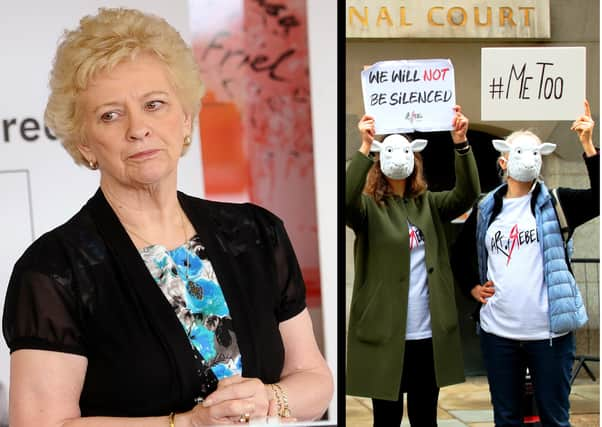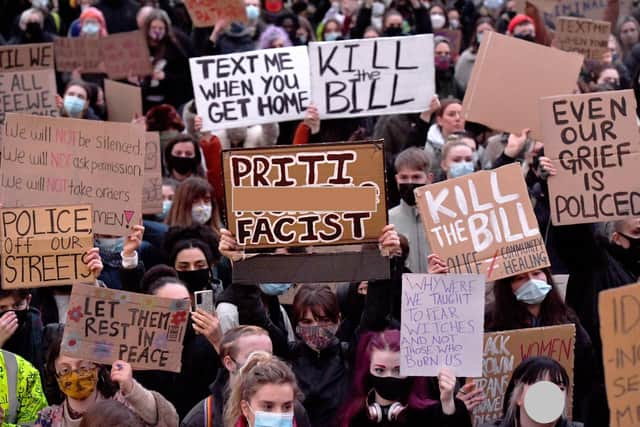Baroness comes to defence of men amid climate of ‘demonisation’


Baroness O’Loan, who has sat as a non-party-political member of the House of Lords since 2009, wrote the article for The Irish Catholic newspaper.
In it she asserts that men are far more likely to be victims of violence than women – something borne out by official crime statistics.
Advertisement
Hide AdAdvertisement
Hide AdShe was speaking amid an upwelling of criticism of male behaviour and attitudes following the killing of Sarah Everard in England (a crime for which a man is awaiting trial).


The upsurge of commentary on social media and the mainstream media alike has seen calls for a “curfew for men” become common.
Meanwhile in Parliament Green Party peer Baroness Jones suggested such a curfew should begin at 6pm, saying “I feel this would make women a lot safer, and discrimination of all kinds would be lessened”.
In her piece for the Irish Catholic, baroness O’Loan recalled her own experience of being pursued at night by a threatening man, and how she narrowly avoided attack.
Advertisement
Hide AdAdvertisement
Hide AdBut she said it is important to remember that “most men are good and kind, and do not lurk constantly waiting to attack a woman or girl”, and that the “grim reality” of crime is that men are more likely to than women to be attacked.
“It is important, too, to ensure that the way we talk about it does not demonise the innocent and does not compound the problem,” she said.
“We must challenge the untrue and damaging narrative which is beginning to prevail. I have listened with growing disbelief to some of the public discourse...
“People increasingly talk about the problem of ‘men’. In so doing they bracket together the small minority of men who might inflict violence on another person and the majority of men who would never do such a thing.
Advertisement
Hide AdAdvertisement
Hide Ad“What does this do to today’s little boys and girls as they grow up? Do little girls begin to think that all men are evil, as the dialogue suggests?”
She added: “I think we need to be very careful in our public discourse that we do not instil unwarranted fear in young people – fear of being attacked, and fear of being seen as an attacker.
“We need to think again, and to use language which is capable of identifying evil without casting all men as evildoers.”
The PSNI has produced stats showing long term crime trends from 2007/8 to 2018/19.
Advertisement
Hide AdAdvertisement
Hide Ad> These reveal that out of 78 “domestic abuse homicides” over that period, 32 of the victims were male and 46 were female – in other words, men made up about 41% of the deaths.
> Meanwhile the number of crimes in general where males were violently injured stood at 126,568, compared with 67,093 for females.
> And the number of recorded crimes of violence which did not result in injury stood at 82,114 for males, and 63,258 for females.
> However, feminist campaigners have long argued the extent of violence against females is in fact hidden behind closed doors, in domestic and family settings.
Advertisement
Hide AdAdvertisement
Hide Ad> It is hard to find PSNI data breaking down homicides (murder, manslaughter etc) by gender. But data from England and Wales shows there were 9,167 male homicide victims and 4,238 female ones from 2000 up to 2020.
> During Northern Ireland’s most violent years, 1969 to 2001, Ulster University’s CAIN project records 3,210 killings of males, and 322 killings of females.
> The PSNI figures also illustrate that the rate of sexual crime against females is astronomically higher than for males; from 2007/08 to 2019/20, there were 6,291 sexual offences recorded against males, and 25,674 against females.
The News Letter contacted no fewer than four different men’s advocacy groups in the UK to discuss the above figures, especially those concerning domestic crimes. Not one of the groups responded.
Advertisement
Hide AdAdvertisement
Hide AdA message from the Editor:
Advertisement
Hide AdAdvertisement
Hide AdThank you for reading this story on our website. While I have your attention, I also have an important request to make of you.
With the coronavirus lockdown having a major impact on many of our advertisers — and consequently the revenue we receive — we are more reliant than ever on you taking out a digital subscription.
Subscribe to newsletter.co.uk and enjoy unlimited access to the best Northern Ireland and UK news and information online and on our app. With a digital subscription, you can read more than 5 articles, see fewer ads, enjoy faster load times, and get access to exclusive newsletters and content.
Visit https://www.newsletter.co.uk/subscriptions now to sign up.
Advertisement
Hide AdAdvertisement
Hide AdOur journalism costs money and we rely on advertising, print and digital revenues to help to support them. By supporting us, we are able to support you in providing trusted, fact-checked content for this website.
Alistair Bushe
Editor